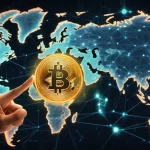Garantex Defies Sanctions: $15M in Crypto Moved, Grinex Emerges as Successor

Russia’s Garantex Evades Sanctions: Millions in Crypto Moved Despite USDT Freeze
Sanctioned Russian cryptocurrency exchange Garantex continues to thumb its nose at international efforts to curb its operations. Despite a high-profile freeze of $26 million in Tether (USDT) assets by the United States, Germany, and Finland in March, blockchain analytics reveal an additional $15 million in crypto tied to Garantex remains active and on the move across multiple networks. Even more alarming, a suspected successor named Grinex is emerging from the shadows, potentially signaling a brazen rebranding to skirt enforcement.
- Sanctions Bypassed: Garantex controls $15 million in unfrozen assets across Bitcoin, Ethereum, BNB Chain, and TRON.
- Obscuring Tactics: Funds are funneled through mixing services like Tornado Cash and shifted to low-cost chains like TRON, hinting at money laundering.
- Grinex Rising: Evidence points to Grinex as a successor, with billions in transactions linked to Garantex’s legacy wallets.
The Backstory: Garantex’s Long Rap Sheet
Garantex isn’t a new name in the crypto underbelly. Sanctioned by the U.S. Treasury in 2022 for allegedly facilitating over $100 million in illicit transactions—think ransomware payments and darknet market deals—this Russian exchange has been a thorn in the side of regulators since geopolitical tensions flared with Russia’s actions in Ukraine. The coordinated freeze of $26 million in USDT earlier this year was meant to cripple its operations, a stablecoin pegged to the U.S. dollar often used for its stability in volatile crypto markets. Yet, as blockchain analytics firm Global Ledger has uncovered, Garantex is far from down and out. Their latest report, as highlighted in a recent analysis of Russia’s crypto exchange Garantex moving millions, shows $15 million in assets still under Garantex’s control, untouched by the freeze, and actively moving across major blockchain networks like Bitcoin (BTC), Ethereum (ETH), BNB Chain, and TRON. This isn’t just a slip through the cracks; it’s a damning exposé of how decentralized systems can be gamed when enforcement lags behind tech.
How Garantex Keeps the Funds Flowing
Let’s break down the mechanics of this evasion, starting with the raw data. On March 6, a previously dormant Ethereum wallet tied to Garantex woke up, aggregating a staggering 3,265 ETH—worth roughly $8.6 million at the time, though prices fluctuate wildly in crypto. Between May 22 and June 4, about 844.99 ETH, or $2.25 million, was routed through Tornado Cash, a decentralized mixing protocol on Ethereum. For the uninitiated, mixing services work like a digital money blender: they pool funds from multiple sources and spit them out in randomized transactions, making it nearly impossible to trace the original owner. It’s a tool with legitimate privacy uses, but also a go-to for laundering dirty crypto. Global Ledger didn’t hold back on their assessment of this activity, as noted in a detailed report on Garantex’s blockchain maneuvers.
“These patterns strongly suggest an intentional money laundering effort to obscure links to Garantex. The activity is ongoing, with real-time alerts continuing to track fresh outflows from this same reserve.”
Elsewhere, Garantex-linked Bitcoin holdings have grown to 30.04 BTC, valued at approximately $3.17 million, with 2.2 BTC bridged over to the TRON network—more on TRON’s allure for rogue players shortly. On BNB Chain, a blockchain backed by Binance, around $4 million in Garantex assets sit idle since March 6, unaffected by the USDT freeze since BNB Chain isn’t a major hub for Tether. Then there’s USDC, another dollar-pegged stablecoin, with Garantex wallets holding 73,283 units, and a sly 290,000 USDC moved to a top-10 exchange deposit address just before the freeze. Smells like someone saw the hammer coming and dodged it with precision.
TRON: The Getaway Car of Blockchains
Why TRON, you ask? It’s not a random choice for shuffling funds. TRON is a blockchain known for lightning-fast transactions and rock-bottom fees, especially for stablecoins like USDT. With a staggering $73.8 billion in USDT circulating on TRON compared to just $5 billion on BNB Chain, it’s the deep end of the liquidity pool. Recent upgrades have made USDT transfers completely gas-free on TRON, meaning moving millions costs nothing—nada, zilch. Compare that to Ethereum, where gas fees can chew up dollars per transaction, or Bitcoin, where confirming a transfer can feel like waiting for paint to dry. Lex Fisun, CEO of Global Ledger, laid it out plain and simple, with insights echoing discussions on TRON’s facilitation of crypto transactions.
“TRON is cheap, liquid, and fast. If your end goal is to swap BTC into stablecoins, bridging straight into the chain that already dominates those flows is the path of least resistance.”
Fisun also hammered home the cost advantage.
“Transfers [on TRON] cost less than what you’d pay on Bitcoin or Ethereum. Even non-subsidised tokens still cost fractions of a cent, and for USDT, moving value is literally free, with recent gas-free upgrades.”
Here’s the kicker: stats suggest 70% of potentially criminal stablecoin transactions happen on TRON. It’s not just a budget airline for blockchain transfers; it’s the getaway car for anyone looking to move dirty money fast and cheap, as explored in studies on TRON’s role in money laundering. Regulators are left scrambling while bad actors zip through these digital highways with ease.
Grinex: Same Game, New Name?
Enter Grinex, the plot twist no one wanted. Suspected to be Garantex’s successor, this shadowy entity has reportedly moved over $1.66 billion in crypto through 180 exchanges, with a staggering $2.41 billion in total exposure by late May. That’s a far cry from the $15 million tied directly to Garantex. Even more damning, $60 million in ruble-backed stablecoins flowed straight from Garantex wallets to Grinex-linked addresses, as detailed in recent blockchain analysis of Grinex’s connections. Yury Serov, research head at Global Ledger, called these fund flows “devastating,” noting they’re ballooning daily and exploiting non-EU jurisdictions hosting Russian immigrants to interact with Euro-focused virtual asset service providers (VASPs). Alex Katz, CEO of Kerberus, added a grim reality check.
“Sanctioned entities often rebrand and persist under new names, a pattern exemplified by Garantex’s shift to Grinex. Shutdowns are temporary without addressing root operational tactics.”
This isn’t just evasion; it’s a masterclass in regulatory arbitrage. Shut down one operation, and another pops up with a fresh logo and the same playbook. Grinex’s scale suggests not just a successor, but a sprawling network that could dwarf Garantex’s original sins. Without hard confirmation, we’re left piecing together blockchain breadcrumbs, but the numbers don’t lie—someone’s playing whack-a-mole with sanctions, and they’re winning.
Regulatory Blind Spots in a Multi-Chain Maze
Why isn’t this getting stopped? The answer lies in the fragmented, borderless nature of blockchain tech. Each network operates under different rules—or lack thereof. BNB Chain, for instance, has no “big red button” to freeze assets instantly; enforcement relies on slow off-chain actors, as Fisun pointed out with the PopcornSwap scam that took two years to tackle. TRON, meanwhile, thrives on speed and scale, with little oversight to match its $73.8 billion USDT dominance. Even the EU’s shiny new MiCA framework, designed to tighten crypto regulations, or the delisting of certain USDT pairs, can’t touch jurisdictions outside its reach where entities like Grinex set up shop. Non-EU countries hosting Russian expatriates become backdoors, exploiting legal residency to interface with regulated exchanges. It’s a geopolitical chess game, and crypto’s decentralized nature is the board, with challenges in enforcement elaborated in an expert analysis on multi-chain sanctions.
Then there’s the tech itself. Blockchain transparency is a blessing and a curse—firms like Global Ledger can track every satoshi (Bitcoin’s smallest unit, named after its pseudonymous creator) down to the wallet, but tools like Tornado Cash turn that transparency into a foggy maze. Sanctioned by the U.S. in 2022 for laundering over $455 million tied to North Korea’s Lazarus Group, Tornado Cash still runs on decentralized infrastructure via IPFS and Tor, untouchable by traditional takedowns. Nearly 30% of the $7.6 billion mixed through it since 2019 ties to criminal activity, yet it also shields legit users—like whistleblowers hiding funds from oppressive regimes. How do you kill a tool that’s both villain and hero?
Decentralization’s Dilemma: Freedom or Free-for-All?
As Bitcoin maximalists, we at Let’s Talk, Bitcoin champion decentralization as the ultimate middle finger to broken, centralized financial systems. Bitcoin’s ethos is resistance—unshackling money from state control, empowering individuals with peer-to-peer transactions no bank can censor. But let’s not drink our own Kool-Aid too hard. Cases like Garantex and Grinex expose the ugly flip side: the same freedom that protects privacy can be hijacked by malicious players. When 70% of shady stablecoin deals run through a chain like TRON, and mixing tools let millions vanish into thin air, we’re not just disrupting the status quo—we’re handing crooks a loaded gun, as community discussions on sanctions evasion by Garantex and Grinex have pointed out.
So, where’s the fix? Smarter cross-chain monitoring could help, using AI to flag suspicious patterns in real-time across networks. Community-driven solutions, like incentivizing wallet reporting without centralized overreach, might plug some holes. Global coordination sounds nice, but good luck getting 195 countries to agree on crypto rules when they can’t even align on trade tariffs. The EU’s MiCA is a start, but until non-compliant jurisdictions stop being safe havens, it’s a half-measure. We can’t ignore that altcoin chains like TRON and BNB Chain fill niches Bitcoin doesn’t—cheap transfers, stablecoin liquidity—but they’re also the Wild West for fraudsters. Bitcoin’s purity as sound money is untouchable, yet the broader ecosystem’s mess is everyone’s problem.
Key Questions on Garantex, Grinex, and Crypto’s Dark Side
- How is Garantex still operating despite sanctions?
With $15 million in unfrozen assets across Bitcoin, Ethereum, BNB Chain, and TRON, Garantex uses mixing protocols like Tornado Cash and low-cost networks to keep funds moving, dodging the $26 million USDT freeze. - Why is TRON a hotspot for illicit transactions?
TRON’s dirt-cheap fees, gas-free USDT transfers, and massive $73.8 billion in stablecoin liquidity make it a magnet for quick, untraceable moves—70% of suspect stablecoin deals happen there. - Is Grinex really tied to Garantex?
Strong evidence links Grinex as a successor, with $1.66 billion moved through exchanges and $60 million in ruble-backed stablecoins directly transferred from Garantex wallets, suggesting a rebranding to evade sanctions. - Why are sanctions failing in a multi-chain ecosystem?
Blockchain networks like BNB Chain lack instant freeze mechanisms, TRON prioritizes speed over oversight, and non-EU jurisdictions act as loopholes, outpacing slow regulatory responses. - What does this mean for decentralization’s future?
This saga highlights the clash between crypto’s promise of financial freedom and its exploitation by rogue actors, urging a push for smarter monitoring or global alignment without sacrificing the ethos of borderless money.
Garantex and potentially Grinex aren’t just pesky outliers; they’re stress-testing the limits of a system built to resist control. Blockchain’s open ledger lets us see every move, down to the tiniest fraction of a Bitcoin, yet without teeth to bite, it’s just a pretty record of broken rules. As advocates for effective accelerationism, we want crypto to steamroll outdated finance, but not if it means paving the way for scammers to run rampant. The revolution we’re fighting for—privacy, freedom, disruption—hinges on squaring this circle. Do we double down on tools that shield the worst among us, or forge a path where accountability doesn’t mean surrendering to the old guard? That’s the billion-dollar question, and it’s not getting answered while funds keep slipping through the net, as further explored in a comprehensive blockchain analysis of Garantex’s evasion tactics and background details on the Garantex exchange sanctions.



